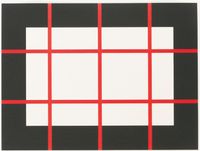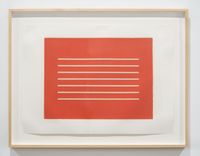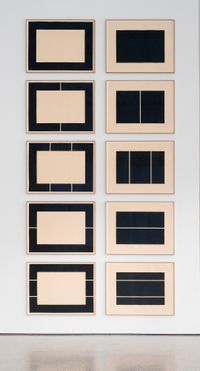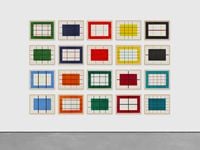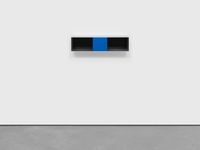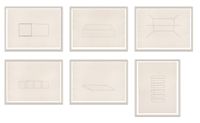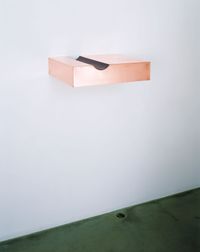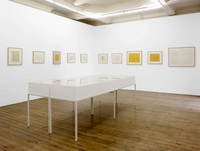Arguably one of the most well-known American post-war artists, Donald Judd was an influential sculptor and critic regarded as an important figure of the Minimalist art movement. He is best known for his 'stacks' of square and rectangular boxes made from industrial materials.
Read MoreBorn in Missouri in 1928, Judd moved to New York where he studied painting at the Art Students League of New York before completing his graduate studies in philosophy and art history at Columbia University. In 1959 Judd began to write articles for Art News, and would later work for Arts Magazine and Art International.
Best known today for his sculpture, Judd began his art practice as an abstract painter. He soon transitioned to sculptural work in the 1960s, culminating in his 'stacks'. In 1968 he would move to Marfa, Texas, where he purchased a five-storey home and studio that became his hub as his art career developed.
Best known for his hollow plexiglass, metal, and wood rectangular and square boxes, Donald Judd's Art, disrupted artistic conventions by relying on industrial materials and processes to produce his work.
The artist's transition from sculpture to painting culminated in his 'stacks'—sets of rectangular cubes that protrude from the wall in vertical columns hung evenly from floor to ceiling. These were made from industrial materials like Iron, steel, and plexiglass. From the mid-1960s Judd employed professional sheet metal fabricators to construct these works.
Untitled (90-7 Bernstein) (1990) is one such work, comprised of ten boxes of red anodised aluminium and transparent plexiglass. Made of industrial materials, Judd's 'stacks' demonstrate his foundational interest in the formal properties of colour, material, form, and space.
Other formats, which Judd developed simultaneously such as his 'Progressions'–a horizontal equivalent–and freestanding box-like forms, follow these same minimalist and industrial design principles as his 'Stacks'. This foundation he continued to build on in sculpture until his passing in 1994.
Judd described his own works as 'the simple expression of complex thought.' Such complex thought was also manifested in the essays that the artist would produce throughout his life. His, still widely referenced seminal essay 'Specific Objects', published in Arts Yearbook 8 in 1965, proposed a painting-sculpture hybrid that reflected his own development in thinking about the two media as well the similar process of conceptual expansion that was contemporaneously occurring for his peers. Negating the artists direct involvement
Pertinent to Judd's practice was a consideration of how a sculpture could exist in a space and how viewers could navigate around it. This interest in spatial dynamics extended to an innovative architecture and design practice.
In the late 1960s the artist designed small shelters in Baja California that would influence his later designs for buildings in Marfa and Europe.
In the 1970s he also began designing furniture for his various residences. Pieces such as Corner Chair 15, designed in 1984, make clear that the artist brought the angularity and refined craftsmanship of his sculptures to the other spheres of his practice as well.
Judd's later woodcut prints, made from 1988 to 1992, reflect the minimalist approach to shape colour and line taken in his sculpture. They comprise of simple geometries, colour rectangles run through with thin horizontal and vertical lines and bars of colour.
Donald Judd has been the subject of numerous solo exhibitions and group exhibitions internationally. Solo exhibitions include Donald Judd, Galerie Thaddaeus Ropac, Salzburg (2021); Judd, The Museum of Modern Art, New York (2020); Obdurate Space: Architecture of Donald Judd, The Center for Architecture, New York (2017); Donald Judd, Los Angeles County Museum of Art, Los Angeles (2013); Donald Judd, Tate Modern, London (2004); Donald Judd: 1960–1991, The Museum of Modern Art, Saitama, Japan (1999); and Kunst + Design: Donald Judd, Museum Wiesbaden, Wiesbaden, Germany (1993.
Group exhibitions include: Go Back to The Future, Espace de l'Art Concret, Mouans-Sartoux, France,(2021); From Gesture to Form, Peggy Guggenheim Collection, Venice (2019); Primary Structures. Museum für Moderne Kunst, Frankfurt (2017); Sculpture After 1945, Musees Royaux des Beaux-Arts de Belgique, Brussels (2013); Art in America: 300 Years of Innovation, National Art Museum of China, Beijing, China (2007); and Abstract Sculpture in America, 1930–70, Musée du Québec, Quebec City (1992).
The Donald Judd Foundation website can be found here.
Ocula | 2022
